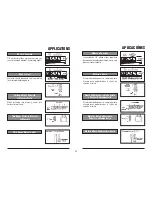
1. Prior to using the tool, make sure it is unload-
ed and then do the functional check: Check
the functioning of the tool, without a powder
load or fastener, by pushing down against
the work surface and pulling the trigger. The
trigger mechanism will make an audible click.
Release the tool from the work surface and
fully extend the barrel to reset the piston.
2. Always check the material being fastened into, by performing the Center
Punch Test: Using a fastener as a center punch, strike the fastener against the
work surface using an average hammer blow and check the results. Wear eye
protection while performing this test.
3. If the base material is suitable for powder
actuated fasteners, make a test fastening
into a suitable base material with a num-
ber 1 (gray) load. If the number 1 load
does not fully set the fastener, try the next
higher power load until the proper level
is found. Failure to properly test fire to
determine correct power level may result
in overpowering the fastener, causing
it to pass completely through the work
material, injuring someone on the other
side. Overpowering the fastener may also
damage the tool.
SAFETY PRECAUTIONS
Prepare for Loading
1. If the fastener point
is blunted, material
is too hard.
2. If material cracks or
shatters, material is
too brittle.
3. If the fastener pen-
etrates the material
easily, material is
too soft.
4. If the fastener makes
small indentation into
material, material is
suitable for fastening.
(Typical base materials: poured concrete, structural steel and masonry.)
NOTE: Ramset loads are designed for
use with Ramset tools. Do not attempt
to use other power loads. Doing so may
lead to unintentional load discharge as
well as damage to the tool. This tool is
NOT designed to use red (5) or purple
(6) power level loads. Using red (5) or
purple (6) loads can result in serious
injury to the operator or bystanders.
Available Power Levels:
Power Level No.
Color
1. Gray
Weakest
2. Brown
3. Green
4. Yellow
Strongest
1.
Antes de usar la herramienta asegúrese de que
esté descargada y entonces realice la revisión de
funcionamiento siguiente: Revise el funcionamiento
de la herramienta sin carga de pólvora ni sujetador;
Revise el funcionamiento de la herramienta sin
carga de pólvora ni sujetador en ella; para ello,
empújela contra la superficie de trabajo y tire
del gatillo. El mecanismo del gatillo emite un
chasquido. Retire la herramienta de la superficie de
trabajo y extienda el barril para reajustar el pistón.
2. Siempre revise el material en el que vaya a fijar; para ello efectúe la Prueba
del Punzón de Marcar. Usando un sujetador como punzón de marcar, pique la
superficie de trabajo con un golpe de martillo común y verifique los resultados.
Tenga puesta protección para los ojos mientras efectúa esta prueba.
3. Si el material base es adecuado para sujetadores
fijados con herramienta de pólvora, realice una
prueba fijando un sujetador en un material base
adecuado con una carga del número 1 (gris). Si
la carga del número 1 no clava completamente
el sujetador, pruebe con una carga del siguiente
número más alto hasta que encuentre el nivel
adecuado. Si no realiza disparos de prueba
para determinar el nivel de potencia correcto,
puede aplicar una fuerza excesiva al sujetador,
causando que éste atraviese el material de
trabajo y pueda lesionar a alguien situado al otro
lado. Si aplica una fuerza excesiva al sujetador
también puede dañar la herramienta.
MEDIDAS DE SEGURIDAD
Preparación para la carga
1. Si se embota la punta del
sujetador, significa que el
material es demasiado duro.
2. Si el material se agrieta
o rompe, significa que es
demasiado quebradizo.
3. Si el sujetador penetra
con facilidad, significa que
el material es demasiado
blando.
4. Si el sujetador hace una
pequeña muesca en el
material, significa que éste
es adecuado para fijación.
(Materiales base típicos: concreto vaciado, acero estructural y mampostería.)
NOTA: Las cargas Ramset están fabricadas para
usarse con herramientas de dicha marca. No
intente usar otras cargas. Si lo hace puede
causar una descarga accidental con los
consecuentes daños a la herramienta. Esta
herramienta NO está fabricada para usar
cargas rojas (5) ni moradas (6). Si se utilizan
cargas rojas (5) o moradas (6), el operador
o los circunstantes pueden sufrir lesiones.
Niveles de potencia disponibles:
Nivel de potencia No.
Color
1. Gris
Menos potente
2. Café
3. Verde
4. Amarillo
Más potente
2





































